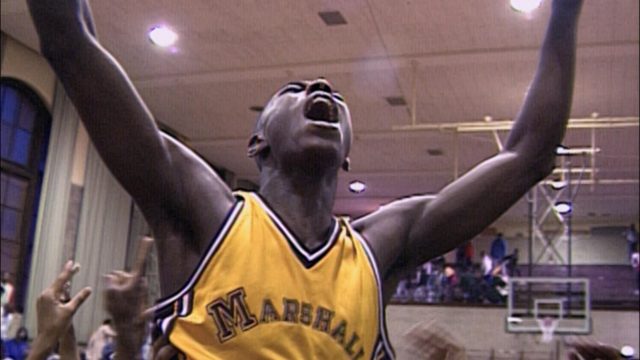- Chicago, center of the professional basketball universe. The Bulls have just won their third consecutive championship and Michael Jordan, widely considered the great basketball player ever (and arguably still is, but LeBron has made the argument more interesting) has shocked the basketball world by retiring in October months after his father’s murder. I, like so many folks living in and around Chicago, was mad for the sport. Then in January of 1994, a nearly three-hour documentary premieres at Sundance and against all odds becomes a major critical and commercial success.
Hoop Dreams is the story of two aspiring high school basketball players in Chicago, William Gates and Arthur Agee, both from lower-class neighborhoods (Gates in Cabrini Green and Agree in West Garfield Park, which is only a mile away from where I am writing this). As the movie opens, they are 8th-graders being recruited by local “unofficial” scouts (and those quotes are deliberate) for local high schools and attract the attention of St. Joseph High School, a nearly-all white Roman Catholic high school out in suburban Westchester. The movie then follows them for the next four-plus years as they struggle with the long commutes on public transportation, keeping their grades up to stay on the team and in school and issues with their parents going in and out of jobs and keeping the lights on (in one instance, literally).
Hoop Dreams in 1994 rightly received a huge amount of praise for the sensitive portrayal of these young men growing up under the eye of the camera, wanting so much to go the NBA in one of that leagues glory periods and wanting to follow in the steps of their heroes like Isaiah Thomas (himself a graduate of St. Joseph). But it also received a lot of praise, deservedly so, for being about the mechanics and the business of recruiting this, essentially, children to win championships and then sometimes abandoning them along the way. There’s a segment in the movie where Agee’s parents fall behind in the half-tuition they owe St. Joseph (both Agee and Gates are attending on a combination of payments and scholarships); back when I watched the movie in 1994, I was angry at St. Joseph and thought they were casting Agee aside for not developing as a player (he ends up at Marshall Metro back in his neighborhood). But now…I feel like, watching the movie again, that they might have been doing that but they also appear to have been letting that tuition slide for a while until they just couldn’t. However, later in the movie, when Agee needs his transcripts to graduate and they won’t release them without payment, there they start coming off as a little hardass again. But again, they are a school that runs on tuition.
And then, oh then, the colleges start sniffing around. It’s not worth naming particular coaches in this part because it’s a quarter century ago, but good lord do they come across as sleazy in trying to say anything to get a player and his family to agree to send their kid there. I’m all flow blowing up the NCAA, and this is some of the most indicting examples of how craven recruiting can be (and really, by 2019 standards I’m betting half of what the coaches are doing here are violations these days). Add in the big, big money (there’s a showcase run by Nike with Dick Vitale as a motivational speaker, and believe me in the comments I’m going to give you the single best dorky photo of Dick Vitale ever) and you start getting a sick feeling in your stomach about how these kids are being sold a line of goods.
Here is where I think the movie does have a small failing; I’m not sure Steve James, the director and one of the main forces behind the movie, quite pushes hard enough on the racial issues involved here. Again and again, you see black players surrounded by, being cajoled by and shouted at by white coaches and administrators and recruiters and I feel James could have dug into that just a little bit more. (Full disclosure, I’m a white guy myself so I can’t exactly speak to it but I certainly was thinking about what might have been.) There are instances of, for instance, Agee’s mother talking about how St. Joseph would have done more for her son if he had already been on the varsity, but they’re not the main focus of the movie by any means.
But that (perhaps) minor quibbling aside, this is still a fantastically done piece of work that even now, 25 years down the road when portions of it feel like ancient history (Cabrini Green has been gone for years, for instance) it’s still incredibly relevant to how sports happens in Chicago and across the US. Both Agee and Gates never made it to the NBA (Agee ended up at Arkansas State and Gates at Marquette) and took different paths in life; last I heard about Agee was a fight in the town next door to me in Forest Park and I believe Gates is a minister in Texas now. Maybe they look back at this movie and see something of themselves in it. Having a documentary about yourself, 25 years later, must seem so odd. I hope they’re OK with that.


